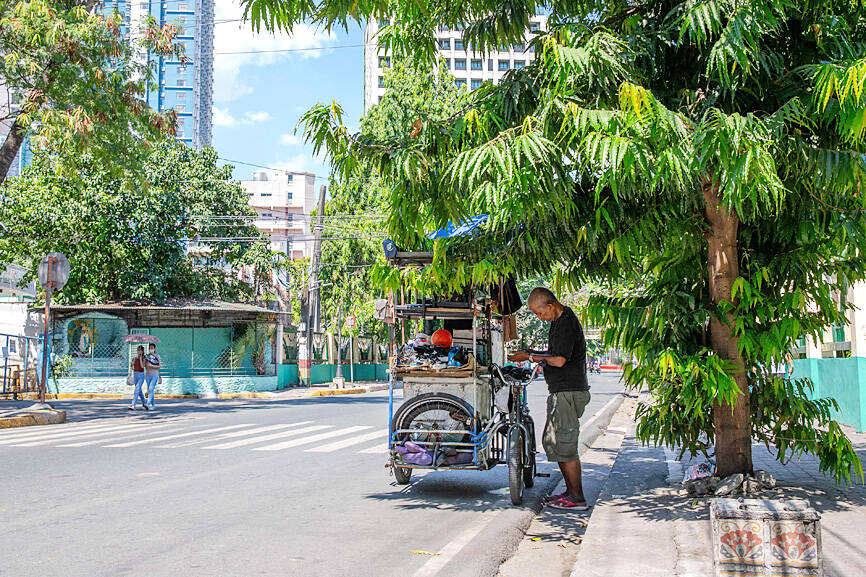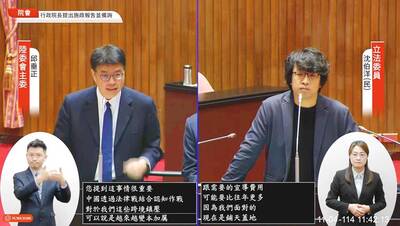The Philippines would suspend in-person classes in all public schools for two days due to extreme heat and a nationwide strike by jeepney drivers, the Philippine Department of Education said yesterday.
Extreme heat has scorched Southeast Asia in the past few weeks, prompting thousands of schools to suspend in-person operations and authorities to issue health warnings. Many schools in the Philippines have no air-conditioning, leaving students to swelter in crowded, poorly ventilated classrooms.
“In view of the latest heat index forecast ... and the announcement of a nationwide transport strike, all public schools nationwide shall implement asynchronous classes/distance learning on April 29 and 30, 2024,” the department wrote on Facebook.

Photo: AFP
The department oversees more than 47,000 schools across the archipelago nation.
Some jeepney drivers also plan to hold a three-day nationwide strike starting today to protest the government’s plan to phase out the smoke-belching vehicles used by many to commute to work and school.
The suspension of in-person classes comes after the temperature in Manila on Saturday hit a record high of 38.8°C, with the heat index reaching 45°C, Philippine Atmospheric, Geophysical and Astronomical Services Administration (PAGASA) data showed.
The heat index measures what a temperature feels like, taking into account humidity.
The hot weather persisted yesterday, with many people flocking to air-conditioned shopping malls and swimming pools for relief.
“This is the hottest I’ve ever experienced here,” said Nancy Bautista, 65, whose resort in Cavite province near Manila was fully booked due to the hot weather.
“Many of our guests are friends and families. They swim in the pool to fight the heat,” Bautista said.
The months of March, April and May are typically the hottest and driest of the year, but this year’s conditions have been exacerbated by the El Nino weather phenomenon.
“All places in the country, not necessarily just Metro Manila, are expected to have hotter temperatures until the second week of May,” PAGASA weather forecaster Glaiza Escullar said. “There is a possibility that the areas will exceed those temperatures being measured today until the second week of May.”
Camiling municipality in Tarlac province, north of Manila, recorded a temperature of 40.3°C on Saturday — the country’s highest this year.
As the mercury rose, Gerise Reyes, 31, said she planned to take her two-year-old daughter to a shopping mall near Manila.
“It’s hot here at home. This is the hottest I’ve ever experienced especially between 10am and 4pm,” she said. “We need a free aircon to cut our electricity bill.”

CALL FOR SUPPORT: President William Lai called on lawmakers across party lines to ensure the livelihood of Taiwanese and that national security is protected President William Lai (賴清德) yesterday called for bipartisan support for Taiwan’s investment in self-defense capabilities at the christening and launch of two coast guard vessels at CSBC Corp, Taiwan’s (台灣國際造船) shipyard in Kaohsiung. The Taipei (台北) is the fourth and final ship of the Chiayi-class offshore patrol vessels, and the Siraya (西拉雅) is the Coast Guard Administration’s (CGA) first-ever ocean patrol vessel, the government said. The Taipei is the fourth and final ship of the Chiayi-class offshore patrol vessels with a displacement of about 4,000 tonnes, Lai said. This ship class was ordered as a result of former president Tsai Ing-wen’s (蔡英文) 2018

‘SECRETS’: While saying China would not attack during his presidency, Donald Trump declined to say how Washington would respond if Beijing were to take military action US President Donald Trump said that China would not take military action against Taiwan while he is president, as the Chinese leaders “know the consequences.” Trump made the statement during an interview on CBS’ 60 Minutes program that aired on Sunday, a few days after his meeting with Chinese President Xi Jinping (習近平) in South Korea. “He [Xi] has openly said, and his people have openly said at meetings, ‘we would never do anything while President Trump is president,’ because they know the consequences,” Trump said in the interview. However, he repeatedly declined to say exactly how Washington would respond in

WARFARE: All sectors of society should recognize, unite, and collectively resist and condemn Beijing’s cross-border suppression, MAC Minister Chiu Chui-cheng said The number of Taiwanese detained because of legal affairs by Chinese authorities has tripled this year, as Beijing intensified its intimidation and division of Taiwanese by combining lawfare and cognitive warfare, the Mainland Affairs Council (MAC) said yesterday. MAC Minister Chiu Chui-cheng (邱垂正) made the statement in response to questions by Democratic Progressive Party (DPP) Legislator Puma Shen (沈柏洋) about the government’s response to counter Chinese public opinion warfare, lawfare and psychological warfare. Shen said he is also being investigated by China for promoting “Taiwanese independence.” He was referring to a report published on Tuesday last week by China’s state-run Xinhua news agency,

‘ADDITIONAL CONDITION’: Taiwan will work with like-minded countries to protect its right to participate in next year’s meeting, the foreign ministry said The US will “continue to press China for security arrangements and protocols that safeguard all participants when attending APEC meetings in China,” a US Department of State spokesperson said yesterday, after Beijing suggested that members must adhere to its “one China principle” to participate. “The United States insists on the full and equal participation of all APEC member economies — including Taiwan — consistent with APEC’s guidelines, rules and established practice, as affirmed by China in its offer to host in 2026,” the unnamed spokesperson said in response to media queries about China putting a “one China” principle condition on Taiwan’s